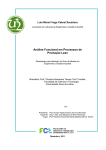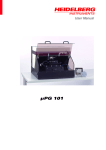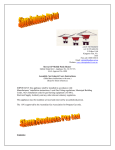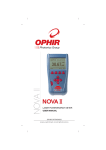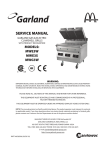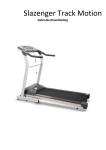Download Sierra Products 13N Specifications
Transcript
A.B.N 76078600450 A.C.N 078 600 450 P.O.Box 1168 Kangaroo Flat, Vic 3555 Free call: 1800 630116 Email: [email protected] Internet Address: www.sierraproducts.com.au Sierra 400N & 400P Overhead Radiant Cone Heater (G.C. No. 237. 09) Sierra 1000N & 1000P Overhead Radiant Cone Heater (G.C. No. 36. 237. 09) Sierra 1500N & 1500P Overhead Radiant Cone Heater (G.C. No. 36. 237. 09) Installation & Servicing Instructions. This appliance shall be installed in accordance with: Manufacturer’s installation instructions- Local Gas Fitting Regulations, Municipal Building Codes, AGA installation code for gas burning equipment (AS5601), Electrical Supply Authority and any other relevant statutory regulation. This appliance must be installed, serviced and removed by an authorized person. Contents: 1.0 Introduction 2.0 Technical Specifications 2.1 General 2.2 Ignition & Flame Sensing 2.3 Spark & Flame Electrode Caps 2.4 Thermostat Range 3.0 General Requirements 3.1 Statutory Requirements 3.2 Location of Heaters 3.3 Gas Supply 3.4 Electrical Supply 3.5 Air Supply Ventilation 4.0 On Site Assembly 4.1 Packing 4.2 Assembly of Heaters 5.0 Installation 5.1 General 5.2 Pipe work to Heaters 5.3 Electrical Supply to Heaters 5.4 Suspension of Heaters 5.5 Initial Lighting and Testing 6.0 Servicing 6.1 Removal of Heater 6.2 Sparks & Flame Electrodes 6.3 Pactrol Control 6.4 Solenoid Valve Coil 6.5 Thermostat 6.6 Injector/ Solenoid Valve 6.7 Burner & Emitter 6.8 Mains Input Lead 7.0 Internal Wiring Diagram 8.0 Short Parts List 9.0 Conversion Additional instruction for Sierra 400P Heater Additional instruction for Sierra 1000P Heater Additional instruction for Sierra 1500P Heater 1.0 Introduction Sierra Overhead Cone Heaters combined ease of installation, economic gas consumption, excellent all-round heating capability, and outstanding safety features. The heaters are ideal for use in factories, warehouses, stores, churches, halls etc. Each heater can be individually set to create any working environment, and by means of its built in thermostat, maintain these conditions. The emitter’s high radiant efficiency gives even distribution of radiant heat. Equable all round temperature is ensured by the shallow profile reflector, additional warmth being evenly and gently released around it periphery. This feature also eliminates wasteful intent up flows which otherwise disturb the natural temperature gradient. An automatic ignition system means that gas is used only when the heater operates- no permanent pilot light is needed, so contributing to the heaters inherent low running costs. 2.0 Technical Specifications 2.1 General Natural Gas (G20) Overall height Overall Width Overall Depth Weight Heater Input Electrical Supply Electrical Consumption Nat. Gas Setting Pressure Burner Injector Size 400N 1000N 1500N 610mm (24”) 860mm (34”) 800mm (31.5”) 9kg (20lb) 30.9 MJ/H 240V/ac 50HZ 17VA 0.75KPA Vertically Positioned With Cast Iron Top, With 30 Flame Ports (4.5mm Deep x 5mm wide) No. 42 (2.75mm) Marked 42 648mm (25.5”) 970mm (38.25”) 895mm (35.25”) 11kg (24lb) 46.8MJ/H 240V/ac 50HZ 17VA 0.75KPA Vertically Positioned With Cast Iron Top, With 40 Flame Ports (4.5mm Deep x 5mm wide) No. 32 (3.30mm) Marked 32 700mm (30”) 1080mm (42.5”) 980mm (38.25”) 18kg (30lb) 87.5MJ/H 240V/ac 50HZ 17VA 0.75KPA Vertically Positioned With Cast Iron Top, With 40 Flame Ports (6.0mm Deep x 5mm wide) No. 12 (4.80mm) Marked 12 AGA Approval No. 4964 2.1 General continued. Propane Gas (G31) Overall height Overall Width Overall Depth Weight Heater Input Electrical Supply 400P 1000P 1500P 610mm (24”) 860mm (34”) 800mm (31.5”) 9kg (20lb) 27.5MJ/H 240V/ac 50HZ 648mm (25.5”) 970mm (38.25”) 895mm (35.25”) 11kg (24lb) 41.4MJ/H 240V/ac 50HZ 700mm (30”) 1080mm (42.5”) 980mm (38.25”) 18kg (30lb) 70MJ/H 240V/ac 50HZ Electrical Consumption 17VA Prop. Gas Setting Pressure 2.75KPA Burner Vertically Positioned With Cast Iron Top, With 30 Flame Ports (4.5mm Deep x 5mm wide) Injector Size No 54 (1.50mm) Marked 54 17VA 2.75KPA Vertically Positioned With Cast Iron Top, With 40 Flame Ports (4.5mm Deep x 5mm Wide) No. 50 (1.9mm) Marked 50 17VA 2.75KPA Vertically Positioned With Cast Iron Top, With 40 Flame Ports (6.0mm Deep x 5mm Wide) No. 42 (2.40mm) Marked 42 AGA Approval No. 4964 2.2 Ignition & Flame Sensing (full Sequence Control) Patrol controls type CS01-12. Pre-purge of ten seconds followed by a trial for ignition of ten seconds. Control will shut down and lock out following an unsuccessful ignition attempt. One attempt at re-ignition will take place following loss of detected flame. 2.3 Spark & Flame Electrode Gaps 2.5mm to 4mm 2.4 Thermostat Range 0*C to 50*C (32*F to 122*F) 3.0 General Requirements 3.1 Statutory Requirements It is the law that all gas appliances installed by authorized persons in accordance with the AS5601. Failure to install appliances correctly could lead to prosecution. It is in your own interest, and that of safety, to ensure that the Law is complied with. 3.1 Statutory Requirements continued. The installation must be completed in accordance with these instructions, and the relevant requirements of the National and Local Building Regulations, the Electrical Supply Authority and any other relevant statutory regulation. Note: The installation code AS5601 is specifically referred to in Government Legislation in some states. 3.2 Location of Heaters The locations chosen for the heaters must permit a satisfactory means of support, and provide adequate space for service access, and must be clear of any sprinkler system, overhead crane or other areas where damage or interference to the heater may occur. The heaters must be sighted so that there is a minimum clearance of 400mm (16”) above, and one meter (40”) sideways, and 2.5 meters (98.5”) below. Any combustible material adjacent to a heater must be shielded so that its temperature does not exceed 50*C. Refer to AS5601 PAGE 137, for definitions of noncombustible material. Determine the number of heaters required, and their mounting heights from the following guidelines:Building Type Suspension Height M2 ft Heater Spacing M2 Sierra 400N & 400P ft Area Heated by each Heater M2 ft Well insulated building of modern construction. Limited air changes Poorly insulated building and/ or excessive air changes 3.8 12.5 3.8 12.5 5 to 6 Well insulated building of modern construction. Limited air changes Poorly insulated building and/ or excessive air changes 4.25 14 9 to 11 30 to 35 90 1000 4.25 14 7.5 to 9 25 to 30 65 700 Well insulated building of modern construction. Limited air changes Poorly insulated building and/ or excessive air changes 6.5 22 11 to 12 35 to 40 140 1500 6.5 22 9 to 11 30 to 35 102 1100 6 to 7 19.5 to 23 42 450 16.5 to 19.5 30 320 Sierra 1000N & 1000P Sierra 1500N& 1500P 3.2 Location of Heaters continued Heaters should not be positioned directly over personnel working in a static position, and not closer than 3mts (10ft) to the roofs of internal offices or stores. When the heaters are intended for use as spot heating, or in open areas where a lower mounting height is required, the manufacturer or Sierra Products P/L should be consulted. 3.3 Gas Supply An existing meter should be checked, preferable by an authorized person, to ensure that the meter is adequate to deal with the rate of gas supply required. Gas supply line and meter must be of adequate size and installed in accordance with the requirements of AS5601 and the local gas authority. The heater gas inlet point is located on the vertical centerline 45mm above the radiant reflector cone. (See figure 1.) Complete installation must be tested for soundness as described in the above standard. 3.4 Electric Supply Electrical wiring to the heater must be installed by a licensed electrician in accordance with the relevant requirements of the SAA Wiring Rules AS 30001991 and any local service rules:“WARNING- THIS APPLIANCE MUST BE EARTHED” 3.5 Air Supply and ventilation The heater is designed as a flueless appliance, and therefore can only be installed where the ratio of room volume to gas consumption complies with the requirements of AS5601. In all cases there must be provision for an adequate supply of air for both combustion and general ventilation. If the total input of the appliance does not exceed 3mj/h per cubic meter of room/ enclosure volume, the required air may be provided by adventitious openings, i.e. gaps around doors, windows etc. If it is necessary to provide room ventilation openings, or mechanical ventilation, this shall be done in accordance with the requirements of AS5601. Detailed recommendations for air supply are given on page 72 of the AS5601. 3.6 Warning: 1. Do not place articles on or against this appliance. 2. Do not use or store flammable materials near this appliance. 3. Do not spray aerosols in the vicinity of this appliance while it is in operation. 4.0 On Site Assembly 4.1 Packing. Sierra 400N and 400P heaters are supplied either fully assembled or in two cartons. 1 No. Reflector 1 No. Emitter 1 No. Burner/ Control Assembly. 1 No. Gas Feed Pipes with Unions 1 No. Main Connection Lead 3 No. M6 Thumbscrews 1 No. Socket Headed Screw 4 No. Nylon Ties 1 No. Set of Instructions (Additional Sets Available if Required) 1 No. Users Instruction Sheet (Additional Sets Available if Required) 1 No. Safety Chain. Sierra 1000N and 1000P heaters are supplied either fully assembled or in two cartons. 1 No. Reflector 1 No. Emitter 1 No. Burner/ Control Assembly. 1 No. Gas Feed Pipes with Unions 1 No. Main Connection Lead 3 No. M8 Thumbscrews 1 No. Socket Headed Screw 4 No. Nylon Ties 1 No. Set of Instructions (Additional Sets Available if Required) 1 No. Users Instruction Sheet (Additional Sets Available if Required) 1 No. Safety Chain. 4.1 Packing continued. Sierra 1500N and 1500P heaters are supplied either fully assembled or in two cartons. 1 No. Reflector 1 No. Emitter 1 No. Burner/ Control Assembly. 1 No. Gas Feed Pipes with Unions 1 No. Main Connection Lead 3 No. M8 Thumbscrews 1 No. Socket Headed Screw 4 No. Nylon Ties 1 No. Set of Instructions (Additional Sets Available if Required) 1 No. Users Instruction Sheet (Additional Sets Available if Required) 1 No. Safety Chain 4.2 Assembly of Heaters 1. Stand heater vertically with emitter at the top. 2. Position reflector over conical emitter, and align three fixing holes with emitter suspension brackets. Insert and tighten three thumbscrews to attach reflector to emitter. 3. Tilt heater so that it rests on the reflector rim with union connection to solenoid valve uppermost. Position gas feed pipe above reflector, and connect union nut a few turns to mate with solenoid valve. 4. Insert socket headed screws through die-casting into centre of reflector top. Tighten moderately. 5. Tighten union with suitable spanner. 5.0 Installation 5.1 General Reference should be made to sections 3.2, 3.3, 3.4, and 3.5 for location of heaters, gas supply piping, electrical wiring and air supply respectively. 5.2 Pipe Work to Heaters Run gas supply lines above proposed position of heaters, and provide dropped lengths in ½ inch BSP mild steel pipe to each heater. As approved service cock must be fitted before each pipe drop to enable the heater gas supply to be isolated for servicing. Support the pipe work adjacent to the ½ inch BSP dropped lengths. This support, by straps, chain or clamps, should be fitted directly to the structure of the building e.g. roof truss. It should be of sufficient strength to take the weight of the heater without sagging of the pipe work. The lower end of each dropped length should be as tabulated, above floor level. Sierra 400N & 400P M 3.8 Ft 12.5 Suspension Height. Sierra 1000N & 1000P M 4.25 Ft 14 Sierra 1500N & 1500P M 6.5 Ft 22 Slip the ring of the safety chain over the threaded end of the ½ mild steel dropped length, and screw on union supplied with each heater. Install the heater and connect safety chain as shown in figure 2. Important: Pressure test the gas installation for soundness, and purge the supplies of air. 5.3 Electrical Supply to Heaters. The heater (s) must be supplied from a separate final sub- circuit protected by an 8 amp fuse or circuit breaker. The “Users Instruction Sheet” must be affixed adjacent to the control switches. NOTE: THIS APPLIANCE MUST BE EARTHED. Typical Installation Wiring The heaters may be controlled by a suitable time switch if required (see above installation diagram). Using the cable ties supplied, strap the supply flexible cord to its dropped gas supply pipe and either terminate the flexible cord in a suitable junction box or fit a 3 pin plug to the flexible cord and terminate it in a 3 pin socket. 5.4 Suspension of Heaters. Secure hook end of safety chain around heater arm (supply pipe). Attach and tighten the union nut at the heater top to the union. Insert the three pin plug into the heater thermostat box, and using the cable ties supplied, strap the main leads to the gas feed pipe on the side facing away from the emitter. 5.5 Initial Lighting and Testing. 1. Turn on the service cock to each heater and set thermostat(s) fully clockwise. 2. Switch on electrical supply, and override the time switch if necessary to enable heaters to ignite. Should any heater fail to ignite because of air in the gas supply pipes, interrupt the electrical supply for twenty seconds to allow a further ignition attempt. 3. Check and adjust gas pressure in accordance with the table below. Sierra 400N 0.75 KPA Sierra 400P 2.75 KPA Natural Sierra 1000N 0.75 KPA Propane Sierra 1000P 2.75 KPA Sierra 1500N 0.75 KPA Sierra 1500P 2.75 KPA 4. Allow premises to reach required temperature, and then set each heater thermostat so that is just switches off. 5. Set time clock to customer’s requirements, ensuring that ‘on’ Periods start three quarters of an hour before the building is occupied. Make sure that a responsible person understands the functioning of the heaters and the use and adjustments of the time clock. 6. Check that the “User Instruction Sheet” is permanently fixed adjacent to the heaters on/ off switch. Advise the user or purchaser that, for continued efficient and safe operation of the heaters, it is important that adequate servicing is carried out at intervals recommended by the Local Gas Authority. If the heater cannot be adjusted to perform or operate correctly, contact the authorized service agent in your state. 6.0 Servicing It is recommended that servicing of the appliance be carried out prior commencement of each heating season and must be carried out by an authorized person. Important note: in the interest of safety, it is recommended that the heater(s) be removed and put on a bench for servicing. It is advised to invert the heater over a shallow cardboard box for the majority of servicing operations. Always check for gas soundness after servicing of the heaters. WARNING: ISOLATE MAINTENANCE. 6.1 POWER SUPPLY BEFORE ATTEMPTING To Remove Heater from Suspension Pipe. 1. Disconnect the electrical supply to heater(s). 2. Disconnect mains cable from junction/ box plug socket leaving high temperature mains cable on heater in place. 3. Turn off the gas at the service cock, and disconnect the heater at the union cock, taking precautions to adequately support its weight. 4. Unhook the safety chain. Note: use only a high temperature type of plastic tie or metal buckle when replacing heater- a suitable clip is 10 x MC6. 6.2 To Remove Spark or Flame Electrode 1. Disconnect electrode wires from (terminal 1 spark) and (terminal 4 flame) on Pactrol base. 2. Using stubby screwdriver, undo and remove retaining screw. 3. Remove electrode from bracket by pulling downwards. 4. To replace electrodes reverse above procedure. Note: after replacing electrode. Check there is a gap of 2.5 to 4mm between electrode top and burner flame port face. Do not cross electrode leads when replacing. 6.3 To Remove Pactrol Full Sequence Control. 1. Fully loosen the two plastic headed screws holding control to base. 2. Carefully pull off control from base. Note: when replacing control ensure that all rubber grommets are correctly positioned in mounting base. Do not over tighten plastic headed screws. 6.4 To Remove Solenoid Valve Coil. 1. Remove pactrol control as described above. 2. Disconnect solenoid valve wires from terminals 3, 5 and 7 of pactrol base. Remove cable retaining tie and rubber grommet. 3. Remove circlip washer from top of coil and remove coil from solenoid body. Note: when replacing coil refit rubber grommet and “new” cable tie. Ensure that the coil lead length is a maximum of 250mm, and that the lead entry to coil is positioned away from burner pan. This is to prevent coil lead from touching burner pan. 6.5 To Remove Thermostat 1. Remove (4) M3 screws holding cover to thermostat box. 2. Pull off receptacle connection from thermostat. 3. Remove screw and clip holding phial to underside of box. 4. Pull off thermostat knob and undo two screws holding bezel and thermostat. Note: when replacing thermostat ensure that connections are made to terminals “1” and “2” and that thermostat capillary tube is well clear of electrical connections. Also ensure bezel is refitted incorrect position pointer mark at bottom. (See Fig 1.) 6.6 To Remove Injector/ Solenoid Valve Assembly 1. Remove circlip washer from top of solenoid valve coil, and remove coil from solenoid body. 2. Undo union adjacent to solenoid valve. 3. Undo 2 socket headed screws using 5mm Allen Key, holding die cast injector holding to burner pan. 6.7 To Remove Burner and/ or Emitter. 1. Remove injector/ solenoid valve assembly as described above. 2. Remove screws attaching spark/ flame electrodes to burner pan. 3. Undo two socket headed screws using 5mm Allen Key, holding burner pan to burner and takeaway burner pan from heater. 4. Turn heater over, and remove three thumbscrews holding reflector to emitter. 5. Using a 13mm Spanner, undo the hex headed setscrew and remove the clamp plate holding the emitter to the burner. Note: Re-assembly is a reverse of the above, when replacing burner pan ensure that the pactrol is on the same side of the burner as the two electrodes. Re-check electrode gap- (Refer to C1.6.2) 6.8 Main Input Lead The mains input lead consist of 3 meters (10ft) of 3 core flexible EPR/CSP having cross sectional area of 0.75mm2 and a continuous operating temperature rating of 85*C. Note: this mains lead must not be replaced by a cable having a lower temperature or current rating. 7.0 Internal Wiring Diagram 8.0 Short Parts List Manufacturers: Sierra Products P/L P.O.Box 1168 Kangaroo Flat Vic 3555 Appliance Name and Model No. Key No. Description 1 2 3 4 5 6 7 8 9 8.0 Injector (natural gas) No. 42 (2.75mm) Flame Electrode with Lead Spark Electrode with Suppression Lead Burner Complete with Electrode Bracket Pactrol CSS01-12 Solenoid Valve Coil Thermostat Thermostat Knob Cable Ties Sierra 400N No. Off 1 1 1 1 1 1 1 1 4 Key No. Description Injector (natural gas) No. 32 (3.30mm) Flame Electrode with Lead Spark Electrode with Suppression Lead Burner Complete with Electrode Bracket Pactrol CSS01-12 Solenoid Valve Coil Thermostat Thermostat Knob Cable Ties Sierra 1000N No. Off 1 1 1 1 1 1 1 1 4 Appliance Name and Model No. Key No. Description 1 2 3 4 5 6 7 8 9 2065 4549 4600 2045 4194 2794 3108 3109 3107 Short Parts List continued Appliance Name and Model No. 1 2 3 4 5 6 7 8 9 Makers Part No. Injector (natural gas) No. 12 (4.80mm) Flame Electrode with Lead Spark Electrode with Suppression Lead Burner Complete with Electrode Bracket Pactrol CSS01-12 Solenoid Valve Coil Thermostat Thermostat Knob Cable Ties Makers Part No. 1896 4549 4600 1905 4194 2794 3108 3109 3107 Sierra 1500N No. Off 1 1 1 1 1 1 1 1 4 Makers Part No. 1932 4549 4600 1928 4194 2794 3108 3109 3107 Appliance Name and Model No. Key No. Description 1 2 3 4 5 6 7 8 9 8.0 Injector (Propane gas) No. 54 (1.50mm) Flame Electrode with Lead Spark Electrode with Suppression Lead Burner Complete with Electrode Bracket Pactrol CSS01-12 Solenoid Valve Coil Thermostat Thermostat Knob Cable Ties Sierra 400P No. Off 1 1 1 1 1 1 1 1 4 Key No. Description Injector (propane gas) No. 50 (1.90mm) Flame Electrode with Lead Spark Electrode with Suppression Lead Burner Complete with Electrode Bracket Pactrol CSS01-12 Solenoid Valve Coil Thermostat Thermostat Knob Cable Ties Sierra 1000P No. Off 1 1 1 1 1 1 1 1 4 Appliance Name and Model No. Key No. Description 1 2 3 4 5 6 7 8 9 2064 4549 4600 2045 4194 2794 3108 3109 3107 Short Parts List continued Appliance Name and Model No. 1 2 3 4 5 6 7 8 9 Makers Part No. Injector (Propane gas) No. 42 (1.40mm) Flame Electrode with Lead Spark Electrode with Suppression Lead Burner Complete with Electrode Bracket Pactrol CSS01-12 Solenoid Valve Coil Thermostat Thermostat Knob Cable Ties Makers Part No. 1895 4549 4600 1905 4194 2794 3108 3109 3107 Sierra 1500P No. Off 1 1 1 1 1 1 1 1 4 Makers Part No. 1931 4549 4600 1928 4194 2794 3108 3109 3107 9.0 Conversion between Gases. Sierra Heaters may be converted between natural gas and propane operation. Conversion involves changing to the correct injector and valve regulator spring (refer to part numbers below). Conversion to For use on Injector Spring Data Badge Conversion to For use on Injector Spring Data Badge Conversion to For use on Injector Spring Data Badge 3.5 Part Numbers Sierra 400P Propane (G31) 2064 2796 3357 Sierra 1000P Propane (G31) 1895 2796 3346 Sierra 1500P Propane (G31) 1931 2796 3364 Sierra 400N Natural (G20) 2065 2797 3358 Sierra 1000N Natural (G20) 1896 2797 3347 Sierra 1500N Natural (G20) 1932 2797 3363 Referral to Air Supply Ventilation Air Supply Requirements for Sierra 400P are as Sierra 400N Air Supply Requirements for Sierra 1000P are as Sierra 1000N Air Supply Requirements for Sierra 1500P are as Sierra 1500N 5.2 Referral to Pipe work to Heater Sierra 400P size pipe work to ensure a pressure of 2.75 KPA to each heater. Sierra 1000P size pipe work to ensure a pressure of 2.75 KPA to each heater. Sierra 1500P size pipe work to ensure a pressure of 2.75 KPA to each heater. 8.0 Referral to Short Parts List. Key No. 1 Description Main injector Propane No. 54 Key No. 1 Description Main injector Propane No. 50 Key No. 1 Description Main injector Propane No. 42 Sierra 400P 2064 Sierra 1000P 1895 Sierra 1500P 1931 Sierra 400N NG No. 42 . 2065 Sierra 1000N NG No. 32 . 1896 Sierra 1500N NG No. 12 . 1932 Safety Chain Installation Warranty Guarantees all products supplied against any manufacturing defect for a twelve month period from date of sale. The Warranty does not cover the following: 1. Faults/ Failure caused by misuse, neglect or faulty adjustments by the user. 2. Failure resulting from not using the product in accordance with the operating instruction manual. 3. Failure as a result of sudden impact. 4. Failure which had occurred from normal fair, wear and tear. 5. Any unit which has been serviced or repaired, taken apart of tampered with by any person not being a qualified installer. 6. The benefits conferred by this warranty and guarantee are in addition to all other rights and remedies in respect of such appliance has under the Trade Practices Act (Commonwealth) and other state and territory laws. Our goods come with guarantees that cannot be excluded under the Australian Consumer Law. You are entitled to a replacement or refund for a major failure and for compensation for any other reasonable foreseeable loss or damage. You are also entitled to have the goods repaired or replaced if the goods fail to be acceptable quality and the failure does not amount to a major failure. Warning This Emitter is coated with a protective oil. Upon lighting this will burn off and there will be some initial smoke. Ensure adequate ventilation. P.O.Box 1168, Kangaroo Flat, Victoria, 3555 Overhead Radiant Cone Heater(s). Type- Sierra 1500N/ 1000N/ 400N/ 1500P/ 1000P/ 400P USER INSTRUCTION SHEET. This appliance shall be installed in accordance with: Manufacturers installation instructions- Local Gas Fitting regulations, Municipal Building Codes, AGA installation code for gas burning equipment (AS5601), Electrical Supply Authority and any other relevant statutory regulation. This appliance must be installed, serviced and removed by an authorized person. Warning: these heaters must be earthed. Sierra Cone Heaters are fully automatic in operation. Each heater has its own individual thermostat which may be adjusted as required to ensure correct comfort conditions in each related area. The heaters ignite when 240v AC is supplied to them. There is a delay of ten seconds before ignition while the electronic circuits carry out a ‘safety start’ check. Should, while running, the heater goes out, it will make one attempt at re-ignition. If the heater fails to ignite, and the small neon light underneath glows, a second attempt at ignition may be interrupting the electrical supply for twenty seconds. The heater can also be controlled by a seven day time clock which should be set to come on about three quarters of an hour before the building is occupied. It may be over-ridden manually if heaters are required outside the selected timings. During the summer time, the heaters need not be switched off, as the heater thermostats will not operate except on a cold day. During the winter shutdown, the heaters may be either switched off or the time clock settings reduced to ‘2 on’ periods of one to two hours to act as frost protection. At the beginning of the heater season, any dust build up of the emitter may be removed with a soft brush or airline, after turning off the electrical supply. It is recommended that the heater be serviced annually, preferable before the beginning of the heating season. Warning: this sheet is to be permanently affixed by the installer immediately adjacent to the isolating switch which controls the electrical supply to the heaters. This switch is only to be used to isolate the heaters E.G for servicing purposes.
























